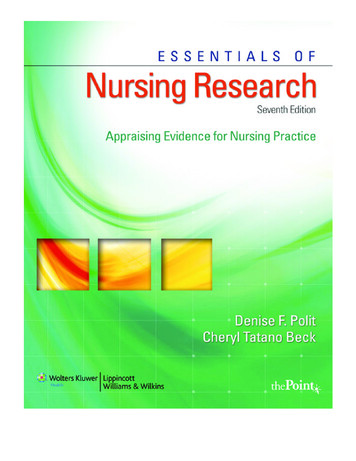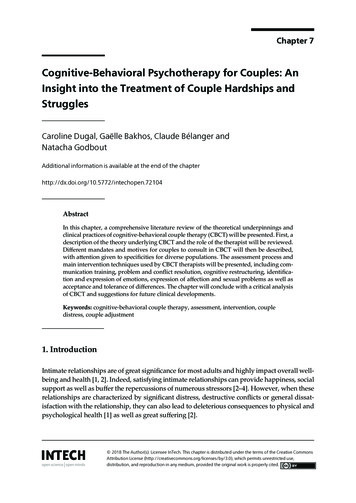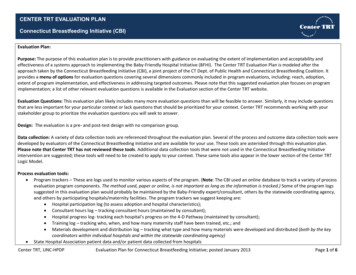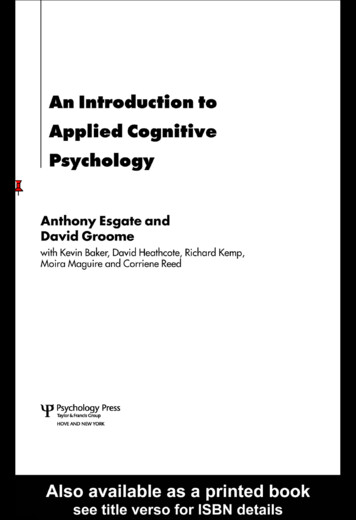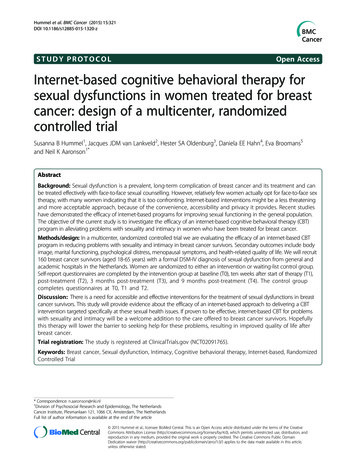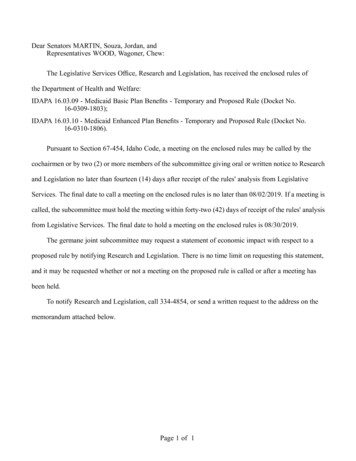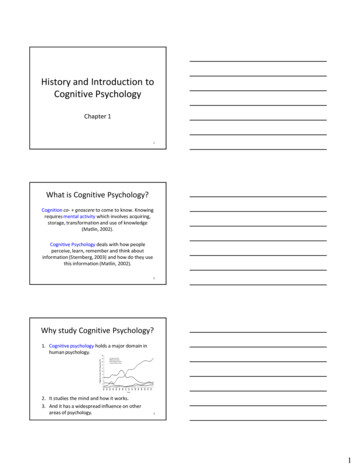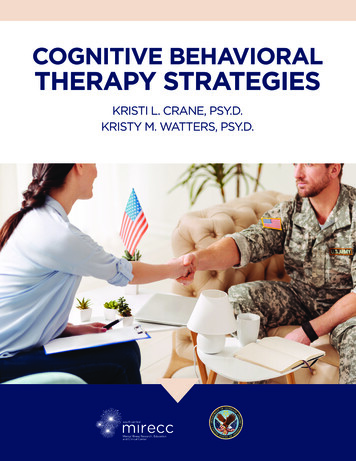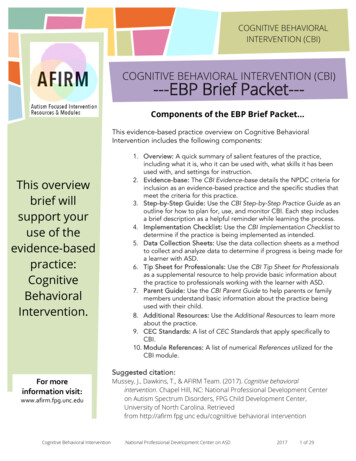
Transcription
COGNITIVE BEHAVIORALINTERVENTION (CBI)COGNITIVE BEHAVIORAL INTERVENTION (CBI)---EBP Brief Packet---Components of the EBP Brief Packet This evidence-based practice overview on Cognitive BehavioralIntervention includes the following components:This overviewbrief willsupport youruse of vention.For moreinformation visit:www.afirm.fpg.unc.eduCognitive Behavioral Intervention1. Overview: A quick summary of salient features of the practice,including what it is, who it can be used with, what skills it has beenused with, and settings for instruction.2. Evidence-base: The CBI Evidence-base details the NPDC criteria forinclusion as an evidence-based practice and the specific studies thatmeet the criteria for this practice.3. Step-by-Step Guide: Use the CBI Step-by-Step Practice Guide as anoutline for how to plan for, use, and monitor CBI. Each step includesa brief description as a helpful reminder while learning the process.4. Implementation Checklist: Use the CBI Implementation Checklist todetermine if the practice is being implemented as intended.5. Data Collection Sheets: Use the data collection sheets as a methodto collect and analyze data to determine if progress is being made fora learner with ASD.6. Tip Sheet for Professionals: Use the CBI Tip Sheet for Professionalsas a supplemental resource to help provide basic information aboutthe practice to professionals working with the learner with ASD.7. Parent Guide: Use the CBI Parent Guide to help parents or familymembers understand basic information about the practice beingused with their child.8. Additional Resources: Use the Additional Resources to learn moreabout the practice.9. CEC Standards: A list of CEC Standards that apply specifically toCBI.10. Module References: A list of numerical References utilized for theCBI module.Suggested citation:Mussey, J., Dawkins, T., & AFIRM Team. (2017). Cognitive behavioralintervention. Chapel Hill, NC: National Professional Development Centeron Autism Spectrum Disorders, FPG Child Development Center,University of North Carolina. Retrievedfrom http://afirm fpg unc edu/cogniItive behavioral interventionNational Professional Development Center on ASD20171 of 29
COGNITIVE BEHAVIORALINTERVENTION (CBI)What is CBI?Learners with ASD often struggle with understanding their emotions, thoughts, behaviors, as wellas how they are all connected. Understanding and insight can be an area of difficulty for learnerswith ASD. Cognitive behavioral interventions can be used to address foundational skills such associal skills, communication, behavior, cognition, coping, and emotional well-being/mental healthconditions (e.g., anxiety, depression, anger). In addition, once some of these foundational skillsare addressed, effects may also be seen on adaptive behavior skills.Evidence-baseCognitive behavioral intervention meets the evidence-based practice criteria set by NPDC with 1single case design study and 3 group design studies. The practice has been effective forelementary (6-11 years) to high school-age learners (15-22 years) with ASD. Evidence-basedpractices (EBP) and studies included in the 2014 EBP report detailed how cognitive behavioralintervention can be used effectively to address: social, communication, joint attention, schoolreadiness, play, vocational, and academic outcomes.How Is CBI Being Used?Cognitive behavioral interventions can be used by professionals such as teachers, specialeducators, speech-language pathologists, paraprofessionals, counselors, and psychologists.Training could take place in a school, clinic, or other community-based setting. Parents and familymembers can also be included in the CBI efforts. Parents and family members also can beinvaluable in supporting the learning, generalization, and maintenance of skills by helping theirchild practice skills in the home and reinforcing the skills they see their child using acrossenvironments.For moreinformation, visit:www.afirm.fpg.unc.eduCognitive Behavioral InterventionNational Professional Development Center on ASD20172 of 29
Cognitive BehavioralIntervention (CBI)---Evidence-base forCognitive Behavioral Intervention--The National Professional Development Center on ASD has adopted the following criteria to determine if apractice is evidence-based. The EBP Report provides more information about the review process (Wong etal., 2014).Efficacy must be established through high quality, peer-reviewed research in scientific journals using: randomized or quasi-experimental design studies (two high quality experimental or quasiexperimental group design studies), single-subject design studies (three different investigators or research groups must haveconducted five high quality single subject design studies), or combination of evidence [one high quality randomized or quasi-experimental group design studyand three high quality single subject design studies conducted by at least three differentinvestigators or research groups (across the group and single subject design studies)].--OVERVIEW-Cognitive behavioral intervention teaches learners to examine their own thoughts and emotions, recognizewhen negative thoughts and emotions are escalating in intensity, and then use strategies to change theirthinking and behavior. Cognitive behavioral intervention meets the evidence-based practice criteria with 1single case design study and 3 group design studies. The practice has been effective with learners inelementary school (6-11 years) to high school learners (15-22 years). Studies included in the 2014 EBPreport detailed how cognitive behavior intervention can be used effectively to address: behavior, social,communication, adaptive, mental, and cognitive outcomes.In the table below, the outcomes identified by the evidence base are shown by age of participants.Early rAdaptiveMentalCognitive Behavioral InterventionNational Professional Development Center on ASD20173 of 29
Cognitive BehaviorIntervention (CBI)Early intervention (0-2 years)No studiesPreschool (3-5 years)No studiesElementary (6-11 years)Drahota, A., Wood, J. J., Sze, K. M., & Van Dyke, M. (2011). Effects of cognitive behavioral therapy on daily living skills inchildren with high-functioning autism and concurrent anxiety disorders. Journal of Autism and DevelopmentalDisorders, 41(3), 257-265. doi: 10.1007/s10803-010-1037-4*Sofronoff, K., Attwood, T., & Hinton, S. (2005). A randomised controlled trial of a CBT intervention for anxiety inchildren with Asperger syndrome. Journal of Child Psychology and Psychiatry, 46(11), 1152-1160.doi: 10.1111/j.1469-7610.2005.00411.x*Sofronoff, K., Attwood, T., Hinton, S., & Levin, I. (2007). A randomized controlled trial of a cognitive behaviouralintervention for anger management in children diagnosed with Asperger syndrome. Journal of Autism andDevelopmental Disorders, 37(7), 1203-1214. doi: 10.1007/s10803-006-0262-3Middle (12-14 years)*Singh, N. N., Lancioni, G. E., Manikam, R., Winton, A. S., Singh, A. N., Singh, J., & Singh, A. D. (2011). A mindfulness-basedstrategy for self-management of aggressive behavior in adolescents with autism. Research in Autism SpectrumDisorders, 5(3), 1153-1158. doi:10.1016/j.rasd.2010.12.012*Sofronoff, K., Attwood, T., & Hinton, S. (2005). A randomised controlled trial of a CBT intervention for anxiety inchildren with Asperger syndrome. Journal of Child Psychology and Psychiatry, 46(11), 1152-1160.doi: 10.1111/j.1469-7610.2005.00411.x*Sofronoff, K., Attwood, T., Hinton, S., & Levin, I. (2007). A randomized controlled trial of a cognitive behaviouralintervention for anger management in children diagnosed with Asperger syndrome. Journal of Autism andDevelopmental Disorders, 37(7), 1203-1214. doi: 10.1007/s10803-006-0262-3High (15-22 years)*Singh, N. N., Lancioni, G. E., Manikam, R., Winton, A. S., Singh, A. N., Singh, J., & Singh, A. D. (2011). A mindfulness-basedstrategy for self-management of aggressive behavior in adolescents with autism. Research in Autism SpectrumDisorders, 5(3), 1153-1158. doi:10.1016/j.rasd.2010.12.012* Research which included participants in multiple age ranges.Cognitive Behavioral InterventionNational Professional Development Center on ASD20174 of 29
Cognitive Behavioral Intervention (CBI)---Step-by-Step Guide--BEFORE YOU START This practice guideoutlines how to planfor, use, and monitorthe practice ofCognitive BehavioralIntervention.Keep in mind thatCognitive BehavioralIntervention can beused to decreaseinappropriatebehaviors andincrease appropriatebehaviors and skills.Each of the following points is importantto address so that you can be sure the selected EBPis likely to address the learning needs of yourstudent.Have you found out more information about. . .? Establish a goal or outcome that clearly stateswhen the behavior will occur, what the targetskill is, and how the team will know when theskill is mastered Identify evidence-based practices If the answer to any of these is “no,” review theprocess of how to select an EBP.For more information, visit:www.afirm.fpg.unc.eduCognitive Behavioral InterventionNational Professional Development Center on ASD20175 of 29
Now you are ready to start Step 1: PlanningThe planning step explains initials steps and considerations involved when using CBI as an intervention for a learner.1.1 Determine if learner has prerequisite skillsDue to the cognitive and linguistic skills needed to engage in CBI, learners with ASD with whom CBI techniqueshave often been utilized have typically had intact intellectual and academic skills that are largely within theaverage range of functioning. Often, necessary skills may include cognitive developmental level aboveapproximately 6 years, expressive and receptive language skills above approximately 6 years, reading levelconsistent with the level of written materials used, and if doing CBI in a group, being group ready (ability to learninformation in a group format, demonstrate appropriate behavior in a group, etc.).1.2 Conduct a functional behavior assessmentA Functional Behavior Assessment (FBA) should be conducted to aid in identifying the most likely function of theinterfering behavior.Note: Check out the module on FBA for more information about this specific process.Use the FBA to gather information on an interfering behavior.1.3 Conduct an assessment of needs and skillsTo address the behavioral piece of CBI, conducting a functional behavior assessment can often be helpful togather information regarding the concerning or interfering behavior including the antecedents andconsequences of that behavior. To address the cognitive piece of CBI, assessing the learners learning style froma perspective of ASD can often be helpful in giving additional information as to why a behavior is occurring andthe learner’s cognitive strengths and weaknesses in order to help develop the intervention strategies to be usedor modify them as necessary.Use the Needs & Skills Assessment Sheet to gather data about a learner’s needs and skills.Use the CBI Planning Sheet as a companion for completing the planning step.1.4 Choose or create a CBI interventionThere are a variety of cognitive behavioral intervention models and evidence-based treatment programs,including those that have been manualized or published, for children, adolescents, and adults to address avariety of issues. These may need to be individualized to the specific learner with ASD you are working with.Cognitive Behavioral InterventionNational Professional Development Center on ASD20176 of 29
Cognitive Behavioral InterventionSTEP-BY-STEPStep 1: Planning (continued)1.5 Obtain training and/or supervision for chosen CBI interventionAn understanding of the fundamental tenets of CBI and its application in general is critical to accurateimplementation of CBI strategies and techniques. Thus, this understanding is essential before using CBI inpractice. Some states, professional organizations, or licensing boards may have guidelines and regulations ontraining requirements and practice considerations. A professional’s training, background, and field of study mayinfluence how much time is required to learn these skills.1.6 Develop a session plana)Determine delivery formatCBI can be carried out in a 1-on-1 or group format, so instructors/interventionists must decide whether toindividually train one learner or to create a group for instruction. The decision will likely be based on variousfactors, including the skills and developmental level of the learner with ASD, the availability of the trainer,availability of space, and scheduling constraints.Select peer(s) for participation:If a group format is selected, the next decision involves what type of learners will be included in thegroup.Consider: Will all learners be in the same grade level or will participants be chosen across several gradelevels? Will all learners have ASD or will children or adolescents with a variety of needs be included? Will peer models be included in the group?Prepare instructors and adults to assist with training:Consider who will provide the intervention. Someone trained in CBI techniques is often the mainprovider preparing and leading the intervention. In a school setting, professionals may be included,such as general education teachers, special education teachers, guidance counselors, speechlanguage pathologists, school psychologists, paraprofessionals, or even parent(s) if family involvementis part of the intervention. Community-based providers may include psychologists, social workers, ortherapists. Make sure all adults who will be leaders are familiar with the principles of CBI as well asspecific lesson plans.Use the Session Planning Sheet as a companion for completing the planning for sessions.b) Determine meeting place and scheduleA meeting time and place for the CBI needs to be selected that is convenient for both the learner(s) with ASD,other members, and the leader. The length of a session can vary greatly from 10 minutes to 90 minutes.Individual sessions are often 45-60 minutes while group sessions are often closer to 90 minutes.Cognitive Behavioral InterventionNational Professional Development Center on ASD20177 of 29
Cognitive Behavioral InterventionSTEP-BY-STEPStep 1: Planning (continued)1.6 Develop a session plan (continued)c)Determine format structureTo ensure the most effective use of time, CBI may involve a common format for each session, depending onthe goal and the type of session planned. At a minimum, a session often includes: a check in, review of that session’s agenda, review current status and events during the time since the last session, review of any homework given, focus on the main agenda items/session content, assigning new homework (based on the main session content for continuity between sessions), and review of the session.Use the Session Planning Sheet as a companion for completing the planning for sessions.Use the Session Plan to guide a CBI session.d) Design individualized programSelect content of lessons:Team members should consider the needs of the learner(s) with ASD and group members (if a groupformat was selected) to determine what will be taught in session. Keep in mind that large topics ofinstruction might include underlying components to the skill that will need to be addressed as well.Select CBI techniques:CBI techniques and common adaptations based on the learner styles of individuals with ASD includepsychoeducation, affect recognition, cognitive restructuring, graded exposure, practice of strategies.Practice of strategies:Modeling, role-play, use of strategies and skills in real situations can be helpful in developing,reinforcing, and generalization of skills.Other adaptations:There are a variety of other adaptations for the learning style of individuals with ASD, includingschedules, chill outs/relation, incorporating interests to increase motivation, and visual countdowns.1.7 Prepare materialsBefore you begin CBI, you will need to prepare the materials. If you have selected any curriculum to supportinstruction, you will need to obtain those materials. Whether you have planned your own lessons or are usingalready created lessons, you will need to look ahead to see what materials are involved in the lessons and makesure you have those materials ready. Copies may need to be made, pictures collected, books checked out, etc.Cognitive Behavioral InterventionNational Professional Development Center on ASD20178 of 29
Cognitive Behavioral InterventionSTEP-BY-STEPStep 1: Planning (continued)1.8 Determine reinforcersWhen teaching a learner new skills, it is important to reinforce use of those skills. This may be a part of asystematic reinforcement system utilized during the course of the intervention. This could include stickers,tokens, points, or some other symbolic system; other options may include tangible items, edibles, or access tospecial items or activities.Step 2: UsingThis section describes following a developed plan when using CBI, reinforcing learner’s use of skills, and maintainingcommunication with team members.2.1 Implement the intervention as plannedRefer back to the plan for instruction you made during the planning step. To plan for each session, use a sessionguide. The session guide can include information about the topic, skill addressed, content, structure, behaviormanagement, instructional strategies, and materials needed.Use the Session Guide to guide a CBI session.2.2 Support generalization of target skillsReinforcement of skills begins in the CBI session, but it should not end there. It is important to plan to supportlearners in generalizing those skills to other settings, people, and activities.Use the Session Homework - Example as a guide for assigning CBI homework.Cognitive Behavioral InterventionNational Professional Development Center on ASD20179 of 29
Cognitive Behavioral InterventionSTEP-BY-STEPStep 3: MonitoringThe following section describe how CBI can be monitored and how to adjust your plan based on the data.3.1 Collect data on learner use of target skillTeam members should collect data on target skills and behaviors. A variety of formats can be used to collect datadepending on the behaviors or skills targeted for instruction and the features of the training.Use the Event Recording Data Collection Sheet to collect learner use of CBI skill.3.2 Determine next stepsCollecting data will help team members determine if a learner is making progress toward the target skill/behavior.If a learner is making progress based upon data collected, team members should continue to use CBI andconsider using it to address additional goals.If the learner with ASD is not showing progress, ask yourself the following questions: Is the target skill or behavior well defined? Is the target skill or behavior measurable and observable? Has the correct target behavior been identified? Are there skills that need to be taught before addressing the target behavior (e.g., expressive socialcommunication goal, teach a new coping strategy)? Do the invention strategies match the student’s learning style and developmental level? Has enough time been devoted to using CBI? Was CBI used with fidelity? (Use the CBI Implementation Checklist to determine fidelity.) Are the visuals and activities appropriate to the student’s developmental level and level of receptivelanguage? Is the skill or target behavior too difficult for the learner or not developmentally appropriate for thelearner based on their developmental level? Is a consistent format used for each session? Are instructional strategies being used consistently? Are reinforcers used that are motivating to the learner? Was the reinforcer applied with fidelity?If these issues have been addressed and the learner with ASD continues not to show progress, considerselecting a different evidence-based practice to use with the learner with ASD or consider completing a problemsolving process to modify current strategies.Cognitive Behavioral InterventionNational Professional Development Center on ASD201710 of 29
Cognitive Behavioral Intervention (CBI)---Implementation Checklist--Before youstart:Have you Determine if learner has prerequisite skillsConduct a functional behavior assessment Conduct an assessment of needs and skillsChoose or create a CBI interventionObtain training and/or supervision for chosen CBI interventionDevelop a session plan:Determine delivery format Determine meeting place and scheduleDetermine format structureDesign individualized programPrepare materialsDetermine reinforcersImplement CBI intervention as plannedSupport generalization of target skillsCollect data on learner use of target skillDetermine next stepsCognitive Behavioral InterventionNational Professional Development Center on ASD201711 of 29
Cognitive BehavioralIntervention---Functional Behavior Assessment--Learner’s Name:Date/Time:Observer(s):Interfering Behavior:A-B-C Data Chart:In the table below, record your r moreinformation, visit:www.afirm.fpg.unc.eduCognitive Behavioral InterventionNational Professional Development Center on ASD201712 of 29
Cognitive BehavioralIntervention---Needs & Skills Assessment--Learner’s Name:Date/Time:Observer(s)/Team Members:Target Behavior(s):Review Records (IEP, assessments, rating skills, and/or other):Notes:Interview Team Members (parent, providers, and/or teacher(s)):Notes:Interview/Observe Learner:DateObserverInitialsCognitive Behavioral InterventionNotesNational Professional Development Center on ASD201713 of 29
Cognitive BehaviorInterventionSummarize Learner Strengths:Summarize Learner Needs:For moreinformation, visit:www.afirm.fpg.unc.eduCognitive Behavioral InterventionNational Professional Development Center on ASD201714 of 29
Cognitive BehavioralIntervention---CBI Planning Worksheet--Learner’s Name:Date/Time:Observer(s)/Team Members):Target Behavior(s):Determine if Learner Has Prerequisite Skills: Attention Recognition of emotions in self Verbal Perspective-Taking Self-reflection Memory Other:Conduct a Functional Behavior Assessment:If a challenging behavior interferes with the child’s ability to learn, than a functional behaviorassessment (FBA) is needed.Conduct an Assessment of Needs and Skills:Review of records and previous assessmentsInterviews with parents, current or recent providers, or teacher(s)Talking with the learnerObservationsUse of formal and/or informal assessment toolsCompletion of rating scalesDetermine Overall Goal for CBI:Develop Session Plan for CBI Program:See the Session Planning Worksheet to develop a Session Plan or Session Guide for CBI.For moreinformation, visit:www.afirm.fpg.unc.eduCognitive Behavioral InterventionNational Professional Development Center on ASD201715 of 29
Cognitive BehavioralIntervention---CBI Session Guide--Learner’s Name:Date/Time:Teacher(s):Setting:Format: Individual GroupItemSESSION TOPICTraining planCompletionstatus Changes/Notes CONTENT/SKILLS TODISCUSS BEHAVIORMANAGEMENT INSTRUCTIONALSTRATEGIES MATERIALSNEEDEDFor moreinformation, visit:www.afirm.fpg.unc.eduCognitive Behavioral InterventionNational Professional Development Center on ASD201716 of 29
Cognitive BehavioralIntervention---CBI Session Planning Worksheet--- Group IndividualIf selecting Group training:Grade level(s) included:Needs of included student:Include peer models: Yes No Modeling Video Modeling Prompting Reinforcement (positive) Visual Supports (visual cues) Social Narratives Peer-mediated Intervention & Instruction (practicing with trained peers) Parent-implemented Intervention (inclusion/instruction to parents) Psychoeducation Direct instruction of skills Cognitive restructuring Teaching underlying concepts Role-play Performance feedback Facilitated practice GeneralizationCognitive Behavioral InterventionCognitive Behavioral InterventionNational Professional Development Center on ASD 2017National Professional Development Center on ASD1201717 of 29
Cognitive BehavioralInterventionWhat natural reinforcers could beused?What activities, objects, and foodsdoes the learner selectindependently?What phrases or gestures seem toproduce a pleasant response fromlearner with ASD?What does the learner say s/hewould like to work for? (ifappropriate)What reinforcers were identified byparents or team members as beingsuccessful in the past?What items did the learner select aspart of the reinforcer sampling?For moreinformation, visit:www.afirm.fpg.unc.eduCognitive Behavioral InterventionCognitive Behavioral InterventionNational Professional Development Center on ASD 2017National Professional Development Center on ASD2201718 of 29
Cognitive BehavioralIntervention---CBI Session Guide--Learner’s Name:Date/Time:Teacher(s):Setting:Format: Individual GroupItemSESSION TOPICTraining planCompletion status Changes/Notes CONTENT/SKILLS TODISCUSS BEHAVIORMANAGEMENT INSTRUCTIONALSTRATEGIES MATERIALSNEEDEDFor moreinformation, visit:www.afirm.fpg.unc.eduCognitive Behavioral InterventionNational Professional Development Center on ASD201719 of 29
Cognitive BehavioralIntervention---CBI Session Guide--Learner’s Name:LaraDate/Time:Teacher(s):Setting:9/7; 9/14ResourceFormat: Individual GroupItemTraining planSESSION TOPICBuilding coping skillsAssessed coping skills currently beingused, selected additional coping skillsof interest to tryWorksheets with frequently usedcoping skills with option to write inadditional skillsIntroduced concept of coping skills,provided worksheet with list offrequently used coping skills, practicestrategies coping skills in session,developed list of coping skills topractice during the week forhomeworkUse of visual schedule to showprogress in sessionDirect instruction, modeling, visualsupportsWorksheets, stress balls, pencilCONTENT/SKILLS MATERIALSNEEDEDCompletion status Changes/NotesBegan workContinue working on identifyingadditional strategies to include incoping toolboxNeed to continue going throughpossible coping strategies as didnot get through all of them andstart preparing those selected toinclude in “coping toolbox” For moreinformation, visit:www.afirm.fpg.unc.eduCognitive Behavioral InterventionNational Professional Development Center on ASD201720 of 29
Cognitive BehavioralIntervention---Session Homework: Coping Strategies--Learner’s Name:Date/Time:Target Behavior(s):Coping Strategies:1. Take a deep breath.2. Count backwards from 10.3. Tell myself, “I can show myself how smart I am by writing down the answer.”4. Tell myself, “It’s ok to make mistakes because it helps the class learn.”5. Remind myself that it’s the teacher’s job to correct other student’s mistakes and help them learn.When did I use each strategy?Date12345TotalFor moreinformation visit:www.afirm.fpg.unc.eduCognitive Behavioral InterventionNational Professional Development Center on ASD201721 of 29
Cognitive BehavioralIntervention---Event Recording Data Collection--Learner’s Name:Date/Time:Observer(s):Target Behavior(s):Event Recording:Use event recording to monitor frequency of target skill/behavior.DateTarget BehaviorCoping Skill UsedLearner’s ResponseAnecdotal Notes:DateObserverInitialsTarget Skill/Behavior, Comments, and Plans for Next StepsFor moreinformation visit:www.afirm.fpg.unc.eduCognitive Behavioral InterventionNational Professional Development Center on ASD201722 of 29
Cognitive Behavioral Intervention (CBI)---Professional’s Guide---CognitiveBehavioralInterventionCBI Is an evidence-based practice for children and youth withautism spectrum disorder (ASD) from 6 to 22 years old.Is based on principle that thinking controls externalbehavior.Teach learners new skills and new ways of thinking thatcan lead to changes in their behavior and actions.Why Use? CBI found to be effective in improving many cognitiveand behavioral skills (social functioning, coping skills, andemotional well-being).CBI can be used to teach new cognitive and/orbehavioral skills that were never learned, teachcompensatory strategies for cognitive deficits that cannotbe changed and/or teach strategies to increase copingand/or decrease mental health symptoms in order toincrease emotional well-being.TIPS: Outcomes The evidence – base for CBI supports the use of thispractice to address the outcomes below: haviorBe sure the learnerhas the neededprerequisitecognitive,expressive, andreceptive skillsneeded toparticipate in CBI.Conduct afunctional behaviorassessment togather informationregarding theinterferingbehavior.Choose or create aCBI interventionthat incorporatescognitivebehavioralstrategies specificto the learningcharacteristics ofthe learner.AdaptiveMentalCognitive Behavioral InterventionNational Professional Development Center on ASD201723 of 29
Cognitive Behavioral Intervention (CBI)---Professional’s Guide--STEPS FOR IMPLEMENTING1. PlanCBIThis tip sheet wasdesigned as asupplementalresource to helpprovide basicinformation aboutthe practice.For moreinformation, visit:www.afirm.fpg.unc.edu 1Determine if learner has prerequisite skillsConduct a functional behavior assessmentConduct an assessment of needs and skillsChoose or create a CBI interventionObtain training and/or supervision for chosen CBIinterventionDevelop a session planPrepare materialsDetermine reinforcers2. Use Implement CBI intervention as plannedSupport generalization of target skills3. Monitor Cognitive Behavioral InterventionCol
Feb 15, 2017 · Understanding and insight can be an area of difficulty for learners . single case design study and 3 group design studies. The practice has been effective for elementary (6-11 years) to high school-age learners (15-22 years) with ASD. . The National Professional Development Center on

